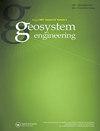Numerical study on the particle distribution of coal for recovery of critical metals
IF 1.1
Q3 GEOSCIENCES, MULTIDISCIPLINARY
引用次数: 0
Abstract
ABSTRACT Coal is considered to be a significant resource of critical metals and minerals. Recovery of these critical metals is considered to be highly important in terms of advancement and technology. This paper presents a numerical study of the particle size distribution of coal and its impact on the recovery of critical metals. This study uses the computational fluid dynamics (CFD) model to simulate the transport and deposition of coal particles inside a helical domain, which can be used as a device for separating particles. The numerical study , based on the particle tracing model for fluid flow and particle tracing, is used to simulate the behavior of coal particles in a slurry under different flow conditions. The transient study for a six-turn helical coil domain is analyzed for different flow velocities ranging from . The simulation results show that the particle size distribution of coal plays a crucial role in the recovery of critical metals. Additionally, the distribution of critical metals inside the domain varies with the size and density of the particles. It is observed that increasing the fluid velocity can significantly increase the recovery of critical metals. Finally, the transmission probability of particles remaining trapped inside the domain is also calculated, which could help in optimizing the helical geometry so that all the particles could come out of the flowing conduit. The number of particles coming out of the helical domain increases with the increase in flow rate. The results of the study show that the particle size distribution of coal plays a significant role in the recovery of critical metals. The findings can help guide the development of more efficient and cost-effective methods for extracting critical metals from coal.煤中临界金属回收颗粒分布的数值研究
本文章由计算机程序翻译,如有差异,请以英文原文为准。
求助全文
约1分钟内获得全文
求助全文

 求助内容:
求助内容: 应助结果提醒方式:
应助结果提醒方式:


